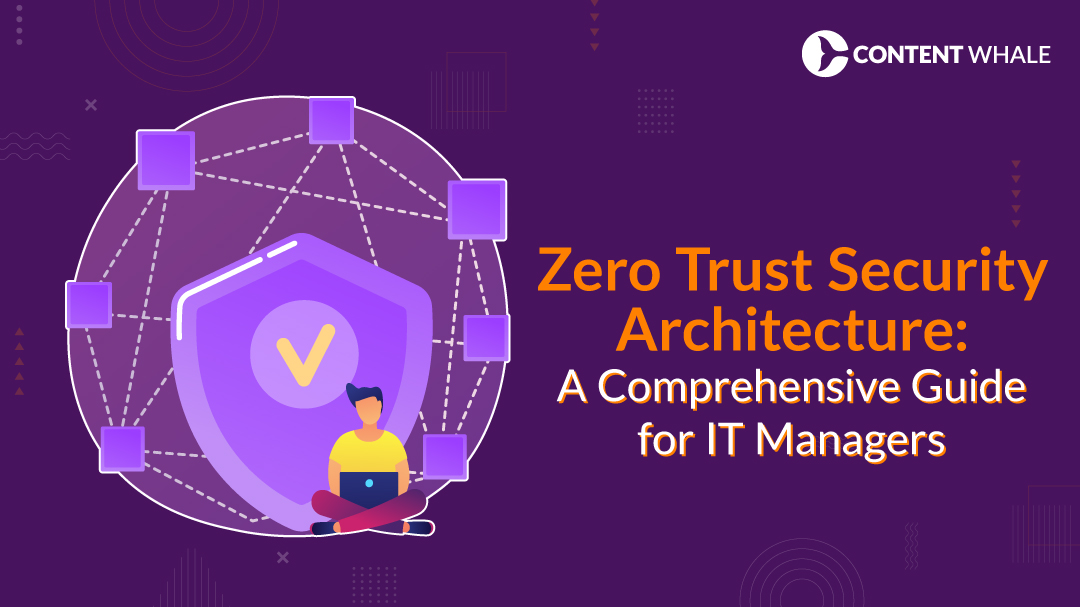As cyber threats become more sophisticated and relentless, relying on traditional security measures has proven to be risky. Zero trust security architecture steps in to fill these gaps, adopting a “never trust, always verify” approach. This modern framework challenges the outdated assumption that systems within the network are inherently safe.
The zero trust model is based on continuous identity verification and enforcing strict least-privilege access for users and devices, ensuring that no one has more permissions than they need. For IT managers, adopting a zero trust network means embracing tighter security, particularly as remote work and cloud-based services continue to expand. By implementing multi-factor authentication, network segmentation, and continuous monitoring, IT leaders can safeguard their systems from internal and external threats.
For businesses that manage sensitive data and remote employees, the shift to zero trust implementation offers a scalable, flexible, and more secure way to manage access. Today’s digital infrastructure requires IT managers to rethink security, and the zero trust security architecture is the future of proactive, layered defense.
1. What is Zero Trust Security Architecture?
Zero trust security architecture is a modern cybersecurity framework that challenges the outdated belief that systems inside a corporate network should be implicitly trusted. Instead, this model assumes that no user, device, or network, whether inside or outside the organization, can be trusted by default. This is essential for securing today’s distributed and cloud-based IT environments, which include a growing number of external users and devices.
Key Features of Zero Trust:
- Identity verification: Each user and device must be verified continuously, utilizing tools like multi-factor authentication (MFA) to ensure that access is legitimate.
- Least-privilege access: Permissions are restricted to the minimum required to perform tasks. This prevents over-permissioning, which can expand the attack surface.
- Network segmentation: Breaking down the network into isolated zones limits the movement of attackers if a breach occurs, reducing potential damage.
- Continuous monitoring: Every activity within the network is tracked in real-time to identify anomalies and detect threats early on.
2. Core Principles of Zero Trust Security

The zero trust security architecture rests on several foundational principles designed to eliminate implicit trust and continuously authenticate users, devices, and applications. Here’s a breakdown of the key principles:
a) Identity Verification
Every access request must be authenticated, whether the user is within or outside the network. This principle revolves around verifying the identity of each user through robust mechanisms such as multi-factor authentication (MFA), ensuring that credentials alone are not enough to gain access. Continuous identity verification helps mitigate risks from stolen credentials and insider threats.
b) Least-Privilege Access
One of the core tenets of the zero trust model is that users and devices are only granted the minimal permissions necessary to perform their tasks. This principle, known as least-privilege access, limits the damage that a compromised account can cause, reducing the chances of lateral movement across the network. IT managers benefit from this by ensuring strict access controls, improving overall security posture.
c) Network Segmentation
Network segmentation divides your network into smaller zones, each with its own access policies. This strategy prevents attackers from moving laterally across the system if they breach one segment. By isolating sensitive assets, businesses can minimize the blast radius of a potential attack, providing greater security against cyber threats.
d) Continuous Monitoring
In a zero trust network, monitoring isn’t optional—it’s critical. Every interaction within the network is scrutinized in real-time to detect anomalies and threats. By employing continuous monitoring and advanced threat detection, organizations can quickly identify and mitigate potential breaches before they cause significant damage.
e) Dynamic Policy Enforcement
The zero trust implementation involves adaptive policies that enforce access rules based on user behavior, device health, and contextual factors. These zero trust policies ensure that access is granted dynamically, aligning with real-time security needs and continuously evolving to address emerging threats.
3. Key Components of Zero Trust Security Architecture
Implementing a zero trust security architecture requires a well-structured approach to ensure that no user or device is implicitly trusted. The architecture is built on several key components that work together to strengthen security and minimize vulnerabilities across your organization’s network.
a) Identity and Access Management (IAM)
IAM serves as the foundation of any zero trust model by ensuring that all users and devices are properly authenticated and authorized before accessing any resources. Tools like multi-factor authentication (MFA) and single sign-on (SSO) are used to add layers of security, making sure that even if credentials are compromised, unauthorized access is prevented. Every session requires continuous identity verification, enhancing security throughout.
b) Policy-Based Enforcement
Enforcement points serve as gatekeepers in a zero trust network, ensuring that access to resources is explicitly authorized based on real-time context. Policies are adapted dynamically, taking into account user roles, device security posture, and other factors. This zero trust implementation ensures that access is granted based on the principle of least-privilege access—only providing the necessary permissions required for specific tasks.
c) Network Segmentation
Network segmentation divides your infrastructure into smaller, isolated zones. This limits lateral movement within the network if an attacker breaches one section. Segmentation is particularly useful for reducing the damage of potential threats by containing breaches and providing more granular control over which users can access which resources.
d) Continuous Monitoring and Security Information and Event Management (SIEM)
Continuous monitoring is essential for maintaining the integrity of a zero trust network. Tools like SIEM collect and analyze data from various sources, helping detect anomalies and security incidents in real time. This ongoing assessment of user behavior and device health ensures that threats are detected and addressed immediately, reducing potential damage.
e) Data Loss Prevention (DLP)
DLP solutions are critical in a zero trust architecture for safeguarding sensitive information. These tools monitor data in motion and at rest, ensuring that unauthorized transfers or leaks are blocked. Implementing DLP helps organizations enforce strict zero trust policies on how data is handled and transferred across the network, protecting against both internal and external threats.
f) Unified Endpoint Management
Ensuring the security of endpoints is another critical component of a zero trust system. Unified endpoint management (UEM) platforms help organizations monitor and control the security of devices accessing the network. This includes enforcing configurations, patch management, and maintaining the overall health of devices, further securing data access and reducing the risk posed by compromised devices.
| # | Component | Description |
| 1 | Identity and Access Management (IAM) | Ensures that only authenticated users with proper access can interact with critical resources, incorporating least-privilege access principles. |
| 2 | Network Segmentation | Divides the network into isolated zones to prevent lateral movement in case of a breach, ensuring attackers can’t access the entire network. |
| 3 | Multi-Factor Authentication (MFA) | Requires multiple layers of identity verification (such as a password and a one-time code) to enhance security for all access requests. |
| 4 | Continuous Monitoring | Monitors all network activity in real time, using analytics to detect and mitigate suspicious behavior as soon as it happens. |
| 5 | Data Encryption | Encrypts sensitive data both in transit and at rest, preventing unauthorized access or leakage of critical information. |
4. Benefits of Zero Trust for IT Managers

Adopting a zero trust security architecture offers numerous advantages for IT managers looking to safeguard complex and dynamic IT infrastructures. Let’s break down the key benefits:
a) Enhanced Security Posture
- Zero trust model continuously verifies every user and device, ensuring no entity—whether inside or outside the network—can be trusted by default.
- This proactive approach drastically reduces the risk of breaches, leveraging identity verification, multi-factor authentication (MFA), and least-privilege access to protect sensitive resources.
Benefit: IT managers can minimize the attack surface, protecting critical systems from both internal and external threats.
b) Improved Threat Detection
- Continuous monitoring is a core aspect of the zero trust network. Real-time analysis of user behavior and system events enables the early detection of anomalies.
- This allows IT teams to respond faster to potential threats, improving overall resilience against sophisticated cyberattacks like ransomware and phishing.
Benefit: Faster response times and better-prepared defenses for modern cyber threats.
c) Reduced Lateral Movement
- Through network segmentation, attackers are prevented from moving laterally across the network, limiting the scope of any potential breach.
- IT managers gain greater control over how data flows through their systems, ensuring that an attacker cannot compromise multiple zones if one is breached.
Benefit: Minimizes the potential damage from security breaches, effectively containing attacks to smaller, isolated areas.
d) Regulatory Compliance
- Zero trust implementation aligns with stringent data protection laws, including GDPR and HIPAA. It enforces zero trust policies that mandate strict access controls, encryption, and detailed audit logs.
Benefit: Helps IT managers meet regulatory requirements efficiently, avoiding penalties and ensuring data privacy.
e) Simplified Security Management
- Zero trust simplifies security administration by centralizing control over access, reducing the burden of managing perimeter defenses.
- IT managers can automate access control and policy enforcement, allowing them to focus on critical tasks rather than constantly overseeing routine security operations.
Benefit: Streamlined management of security policies and automation of routine tasks, making security operations more efficient.
f) Flexibility for Remote Work
- The zero trust network is ideal for supporting remote and hybrid work environments by ensuring secure access from any location or device.
- It verifies each connection, continuously ensuring data remains secure no matter where it is accessed.
Benefit: IT managers can safely support flexible work arrangements without compromising security or user experience.
5. Steps to Implementing Zero Trust in Your Organization
Deploying a zero trust security architecture is a methodical process that enhances security by continuously verifying users and devices within your network. Here are the key steps for successful implementation:
a) Define the Attack Surface
- Begin by identifying the most critical assets that need protection, such as sensitive data, mission-critical applications, and cloud resources.
- Focus your zero trust implementation on these high-value assets first, ensuring maximum security without overwhelming your infrastructure.
Key Consideration: Identify sensitive data, critical applications, and physical or cloud assets that pose the greatest risk if compromised.
b) Map Transaction Flows
- Understand how data moves between users, devices, and applications.
- Mapping these flows helps establish least-privilege access rules by pinpointing the exact interactions that require authorization and monitoring.
Key Consideration: Ensure that only the required users, applications, and devices have access to specific resources based on their roles.
c) Architect the Zero Trust Network
- Design your zero trust network using multi-factor authentication (MFA) for identity verification, network segmentation for containment, and real-time monitoring tools.
- Implement network controls such as next-generation firewalls to secure traffic, and build your network with zero trust principles in mind from the start.
Key Consideration: Ensure all devices, applications, and users are authenticated before they gain access to critical systems.
d) Develop and Enforce Policies
- Use a detailed approach like the Kipling Method (who, what, when, where, why, and how) to create comprehensive zero trust policies.
- These policies should be designed to limit access strictly to the resources users need for their tasks and no more.
Key Consideration: Make your access policies flexible and adaptable to real-time security needs without compromising security posture.
e) Continuous Monitoring and Analytics
- Implement tools for continuous monitoring to track network behavior and detect any anomalies.
- Use real-time analytics and reports to ensure zero trust policies are enforced effectively, and threats are identified early.
Key Consideration: Consistently monitor user behavior and system activity, using automation and AI-driven insights to detect and respond to potential security incidents.
| # | Steps | Description | Benefits |
| 1 | Assess Security Risks | Identify vulnerabilities in your current infrastructure. | Focuses security on areas with the highest risk. |
| 2 | Identify Critical Assets | Prioritize sensitive data and assets for protection. | Ensures vital resources are protected. |
| 3 | Implement IAM & MFA | Enforce strong identity verification and least-privilege access. | Reduces unauthorized access to data. |
| 4 | Apply Microsegmentation | Divide the network into smaller zones to restrict lateral movement. | Contains breaches within isolated areas. |
| 5 | Continuous Monitoring | Monitor network activity in real-time to detect anomalies. | Early detection and rapid response to threats. |
| 6 | Update Policies | Regularly adapt zero trust policies to evolving threats. | Maintains strong, up-to-date security protocols. |
| 7 | Secure Devices and Endpoints | Verify that only compliant devices connect to the network. | Mitigates device-level security risks, particularly for remote work. |
| 8 | Promote Zero Trust Culture | Educate employees on security practices. | Strengthens overall adherence to security measures. |
6. Overcoming Challenges in Zero Trust Adoption

a) Complexity of Integration
Integrating zero trust into existing infrastructures can be daunting, particularly for organizations with legacy systems. Retrofitting older technologies to align with zero trust policies requires significant resources and technical adjustments. Organizations often need to implement new tools, redesign network architecture, and ensure compatibility between different systems.
b) Cultural Resistance
Shifting from a traditional perimeter-based security model to a zero trust model involves a cultural transformation. Employees may resist this new approach as it requires continuous verification of identity and device access. Ensuring that staff understand the importance of this shift and providing comprehensive training is essential to overcoming this resistance.
c) Balancing User Experience and Security
One of the key challenges is maintaining a seamless user experience while enforcing strict security protocols like multi-factor authentication and least-privilege access. Over-complicated security processes can frustrate users, leading to inefficiencies. Finding the right balance between user convenience and security is critical for successful implementation.
d) High Implementation Costs
The initial cost of zero trust implementation can be high, involving significant investments in new security tools, network segmentation, and employee training. Organizations may also need to hire skilled professionals to manage and monitor zero trust networks. Although the long-term benefits often outweigh the costs, securing the necessary budget for such an overhaul can be a barrier for many businesses.
e) Ongoing Management and Maintenance
Zero trust is not a one-time implementation; it is an ongoing process that requires continuous monitoring, updating, and refining. As new threats emerge, zero trust policies must adapt, requiring regular investment in monitoring tools and security updates. This continuous improvement adds to the long-term maintenance burden.
7. Tools and Platforms to Support Zero Trust Architecture
Implementing a zero trust security architecture requires the integration of several tools and platforms that work cohesively to provide continuous verification and secure access across the network. Below are some of the key solutions that support a comprehensive zero trust framework:
a) Identity and Access Management (IAM) Solutions
IAM solutions are foundational for zero trust implementation by ensuring identity verification and enforcing least-privilege access.
- Okta Workforce Identity Cloud: Provides single sign-on (SSO) and multi-factor authentication (MFA) for cloud, on-prem, and hybrid environments. It integrates with over 7,000 third-party applications, making it highly versatile.
- Ping Identity PingOne for Workforce: Delivers adaptive MFA and SSO with granular access controls to help teams manage authentication efficiently in line with zero trust principles.
b) Network Access Control (NAC)
NAC solutions are vital for controlling which devices can access the network and ensuring they meet security standards.
- Cisco Duo: Offers MFA, device visibility, and passwordless authentication, ensuring users and devices meet security requirements before accessing sensitive resources.
c) Microsegmentation Tools
Microsegmentation isolates different segments of the network to limit the potential damage of a breach.
- Palo Alto Networks Prisma Access: Facilitates network segmentation using Next-Generation Firewalls (NGFW) and provides security across both on-premises and remote work environments.
d) Endpoint Detection and Response (EDR)
EDR solutions continuously monitor endpoints for suspicious activity and respond to threats in real time.
- CrowdStrike Falcon: Delivers real-time threat detection and response across all endpoints, ensuring that zero trust policies are enforced and threats are quickly contained.
e) Privileged Access Management (PAM)
PAM solutions control access to privileged accounts, enforcing least-privilege access for sensitive systems.
- CyberArk: A leading PAM solution that restricts privileged account access to authorized personnel, reducing the attack surface and reinforcing the zero trust model.
| # | Tools/Platforms | Used For | Benefits |
| 1 | Okta Workforce Identity Cloud | Identity and Access Management (IAM) | Provides SSO and MFA for secure authentication, enabling seamless access to applications with over 7,000 integrations. |
| 2 | Cisco Duo | Network Access Control (NAC) | Offers MFA, device visibility, and passwordless authentication for zero trust networks, enhancing remote and on-prem access. |
| 3 | Palo Alto Prisma Access | Microsegmentation | Ensures granular access controls, limiting lateral movement within the network using Next-Generation Firewalls (NGFW). |
| 4 | CrowdStrike Falcon | Endpoint Detection and Response (EDR) | Provides real-time monitoring and threat detection across all endpoints, enhancing continuous monitoring capabilities. |
| 5 | CyberArk | Privileged Access Management (PAM) | Secures privileged accounts by enforcing least-privilege access, protecting sensitive systems and reducing the attack surface. |
| 6 | Microsoft Defender XDR | Extended Detection and Response (XDR) | Integrates threat signals across platforms, ensuring real-time detection, analysis, and response to potential threats. |
| 7 | Cloudflare Magic Network | Network and API Security | Monitors network traffic and secures APIs from threats, providing real-time visibility into DNS queries and traffic patterns. |
| 8 | Ping Identity PingOne | Cloud Identity and Access Management (IAM) | Offers adaptive SSO and MFA with granular policies, securing user authentication and simplifying access for large enterprises. |
| 9 | Microsoft Entra Private Access | Zero Trust Network Access (ZTNA) | Replaces VPNs with adaptive authentication, providing secure access to applications for remote users with real-time monitoring. |
Conclusion

Adopting zero trust security architecture is no longer just an option but a necessity for organizations facing modern cybersecurity challenges. The zero trust model provides a dynamic and robust defense by continuously verifying every user and device that interacts with the network. Unlike traditional security systems that trust entities within the perimeter, zero trust assumes that breaches can come from anywhere, reducing the risks associated with implicit trust.
By focusing on identity verification, least-privilege access, and network segmentation, zero trust enables IT managers to enhance their security posture significantly. Additionally, continuous monitoring ensures that threats are detected and contained before they cause significant damage.
Organizations that implement zero trust architecture are better equipped to manage evolving threats, such as supply chain attacks, human error, and remote work vulnerabilities. The framework not only protects sensitive data but also aligns with regulatory requirements and improves cyber resilience across various environments.
Ultimately, zero trust allows organizations to build a more secure, adaptable, and future-ready IT infrastructure, ensuring that they stay ahead of cyber threats in an increasingly complex digital landscape.
_____
This blog is crafted by Content Whale, your trusted partner for high-impact, SEO-optimized content that delivers measurable results. If you’re looking to elevate your brand, boost your rankings, and outpace the competition, we’re here to help. Contact us today, and let’s create content that drives success and takes your business to the next level.
FAQs
1. What is Zero Trust Security?
Zero trust security is a modern cybersecurity framework that operates under the principle of “never trust, always verify.” Unlike traditional perimeter-based models, zero trust architecture continuously verifies the identity and access level of every user, device, and application, regardless of their location—inside or outside the network. This model minimizes the risk of breaches by granting access only to what is necessary for the specific task, ensuring least-privilege access and network segmentation.
2. Why is Zero Trust more effective than traditional security models?
Traditional security models focus on defending the perimeter of a network, assuming everything inside is trustworthy. However, this approach fails against insider threats and lateral movement during a breach. In contrast, zero trust networks continuously verify users and restrict access even within the internal environment, preventing attackers from moving across the network if a breach occurs.
3. What are the key components of Zero Trust?
The core components include:
- Identity verification using strong authentication methods like multi-factor authentication (MFA).
- Network segmentation to isolate critical systems.
- Continuous monitoring to detect unusual behavior in real-time. These elements work together to enforce zero trust policies, limiting access to only authorized users and devices.
4. Can Zero Trust be integrated with legacy systems?
Yes, but it can be challenging. Many organizations have outdated systems that lack the necessary compatibility for zero trust implementation. However, solutions like network access controls and segmentation can be implemented gradually to mitigate security risks while working with legacy infrastructures.
5. How does Zero Trust protect remote workers?
With the rise of remote work, zero trust architecture ensures secure connections by verifying every access request, regardless of location. Features like MFA, device security checks, and granular access control limit the risk of compromised devices accessing sensitive information, enhancing cybersecurity for IT managers in a remote environment.





